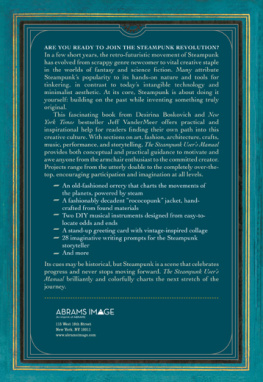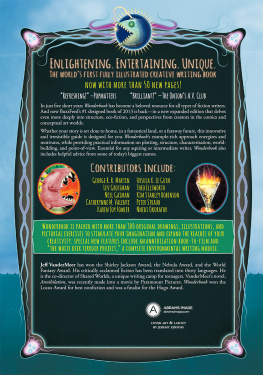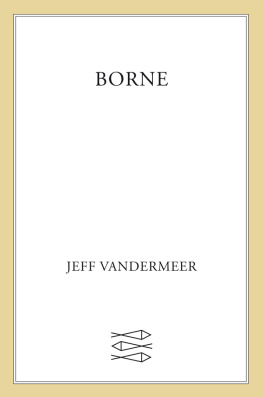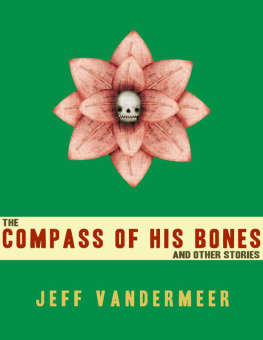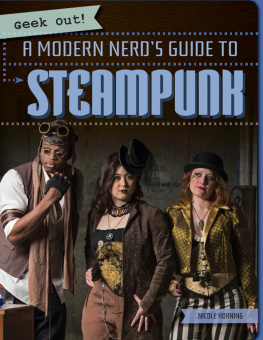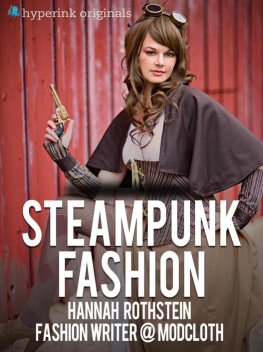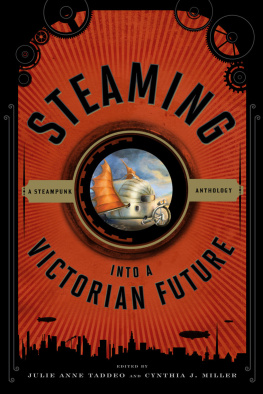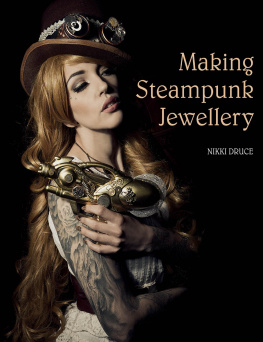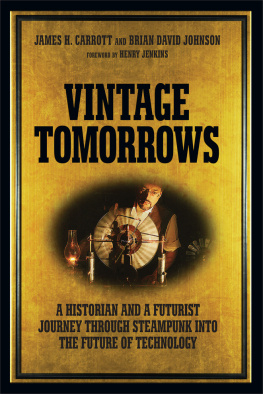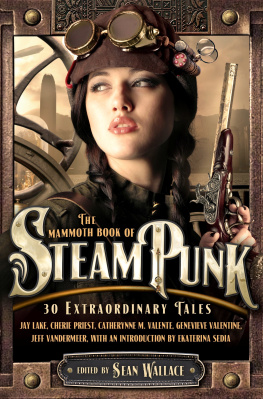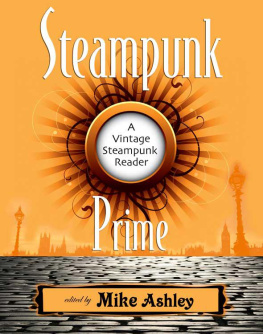
Victorian Robo Detective and Dr. WATTson by Guy Himber

Exorcist by James Ng
CONTENTS

... CHAPTER
STEAMPUNK ART AND MAKING
Projects:
... CHAPTER
STEAMPUNK DESIGN: FASHION, ARCHITECTURE, AND INTERIORS
Project:
... CHAPTER
STEAMPUNK STORYTELLING
... CHAPTER
STEAMPUNK MUSIC AND PERFORMANCE
Project:
... CHAPTER
RETRO-FUTURE FANTASIES AND STEAMPUNK DREAMS

Prague (Praha) by Sam Van Olffen

Artist and maker Thomas Willefords studio

The Great Mechanical Unicorn by Sam Van Olffen

Steampunk musician Andrew ONeill of The Men That Will Not Be Blamed For Nothing. Photo by Ria Osborne. Frame by John Coulthart.

INTRODUCTION
WHY STEAMPUNK?
Both cultural theorists and at-home Steampunkers have dedicated plenty of time to exploring the appeal of the Industrial Age aesthetic for artists, makers, and laypeople alike. There are many reasons that people are drawn to retro-futurism, but one that particularly stands out is the variety and contrast it offers to the prevailing styles of recent decades. For the last thirty or so years, artist and maker Herr Dktor comments, design has been a form of reductionism: computers in plain beige/gray/black boxes, streamlining making cars and other vehicles indistinguishable, and so forth. Steampunk (and its ilk) has allowed some to take a new look at the world around us, with an eye to both the past and the future.
Ramona Szczerba, a psychologist and artist known for her watercolor and collage pieces, agrees. In terms of design, I think its a great balance to ever-more-sleek modernism. While cars and phones and televisions are all becoming impregnable smooth pods that stay inert until you touch them, Steampunk designs favor visible workings and surface ornamentation.... Plus, if it breaks, you stand a chance of fixing it yourself without voiding the manufacturers warranty!
Szczerba also notes Steampunks flexibility as a tool for the imagination: As a psychologist, I suspect that Steampunk is a doorway to creativity and imagination in the same way we consider the Rorschach to be a way to access the unconscious. We are all looking at the same blot, but the interest comes from each individual and what of herself she imposes upon and brings to it.
One thing is certain: Steampunk and the whole of the retro-futuristic aesthetic offer a much broader playground for a creative person, a buffet of intriguing approaches and fresh looks to set ones work apart from the competition. For the working creator, the flexibility of a bigger toolbox may be exceedingly helpful in the day-to-day. As a designer, I think and make in terms of appropriateness for the design strategy and message needs; certain projects call for certain visual aesthetic directions, says Danny Warner. (His pioneering work with motion posters is a concrete example of this principle.) Warner adds, My first Steampunk-inspired work was in the realm of display typography. I used schemata and other iconography of simple machinery to develop new ideas in typographic form.

Rebekah Morin as Red Queen in Third Rails production of Then She Fell. Photo by Adam Jason Photography.
Doktor A is another popular maker and artist of the Steampunk world. His work runs the gamut from zany toys to whimsical sculptures to 2-D art and illustration, and he is particularly known for his Mechtorian seriessteam-powered toys that double as the wacky citizens of a fictional world called Retropolis. Doktor A agrees that the lush looks of retro-futurism are a welcome and refreshing change. I think its nice to see people enjoying embellishment again, he says. I feel that as technology in particular becomes ever more powerful and ever more integrated into our lives that we should not expect it all to be presented in only one style. I think its important that people make it work for them in a way that they are comfortable interacting with, and in a style of their choosing, whatever that may be.
In many ways, Steampunk is the visual vernacular that defines the current era: both our fascination with technology and progress, and our nostalgic longing for a simpler age. Slowly, the aesthetic has slipped into our films, our graphic novels, our fashion, our interior decor, and even our digital lives. Retro-futurism, specifically its blend of midcentury modernism and art deco, has heavily influenced everything from skeuomorphic touch-screen interfaces to modern movies, says Mark Givens, an art and culture scholar and editor in chief of MungBeing Magazine.
Givens also feels that Steampunk is even more deeply tied into the cultural zeitgeist, saying, [Steampunk] has greatly influenced the look and style of the early twenty-first-century youth movementthe hipsterswith its handlebar mustaches, brass, and muted colors.
And now, these hipsters, yuppies, and penny-pinchers alike are developing passions that would make their grandparents proud; theyre mastering forgotten skills and returning to the land, practicing hobbies such as gardening, sewing, canning, quilting, woodworking; even making their own cheese, curing their own meats, and brewing their own beer. The desire to tinker with our machines and create something both functional and beautiful stems from the same core impulse.
The best thing about Steampunk, however, is its big-tent mentality. As Givens says, there is room for makers and tinkers, DIY and craft assemblages, and anachronistic bike riders. Not to mention, a growing global movement of Steampunkers across the world, who are reinventing the looks of retro-futurism with respect to their own unique cultural contexts.
Still not sure? Well, youll discover many more answers to that question in the chapters to follow.
BASICS ABOUT THE CREATIVE PROCESS
At some level, each and every artistic project is unique, with its own problems to solve and its own path from conception to completionespecially if you are the kind of maker who always wants a fresh challenge, a bigger puzzle to solve. That said, there are a few basic steps that usually go into executing a creative project.
Step 1: INSPIRATION. The first step, of course, is getting an idea; this idea frequently emerges as a random burst of inspiration. Other times, the idea evolves as the result of a conscious decision to sit down and brainstorm.
Next page
